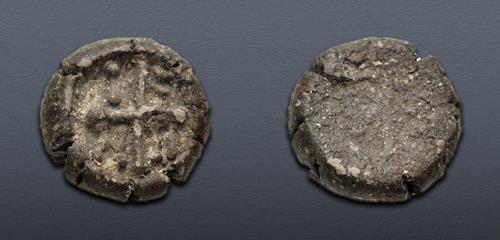|
Circa 7th century AD. Terracotta “True Cross” Pilgrim Relic Token (16.5mm, 1.46 g). Large cross; H - N/ E - I in quarters / Blank. Mitchiner, Medieval Pilgrim & Secular Badges 1062-4. Dark brown earthen patina. Good VF.
From the CJR Collection.
The most precious relic preserved by the Byzantine church was the "True Cross", claimed to be the actual cross on which Jesus Christ was crucified. Discovered in the 320s during the renovations of the pilgrimage sites in Jerusalem under Helena, mother of Constantine the Great, the Cross had been venerated by generations of pilgrims by the seventh century.
In AD 614 the unthinkable occurred. The Sasanian Persians invaded the eastern frontiers of the Byzantine Empire under Khosrau II, ostensibly as the avengers of the deposed and murdered emperor Maurice Tiberius who was Khosrau’s father-in-law. They reached Jerusalem, besieged and captured it, looting and pillaging the famed pilgrimage sites. As part of their triumph they carried away the True Cross to Ctesiphon.
The Cross remained in Persian hands for fourteen years. Meanwhile the new emperor Heraclius made an end to the usurper Phocas whose rebellion had prompted the Persian invasion. Carefully, Heraclius prepared his counterattack. In 628 his army invaded from Armenia and decisively broke the Persian military might. With the fortunes of the war swinging in favor of the Byzantine, they recovered what they had lost, with interest. The Cross was returned to its place of honor in Jerusalem.
The Cross remained in Jerusalem for a further five centuries. Used as a standard in battle by the Crusaders, it was captured at Hattin in 1187 by the Muslims. Eventually, according to tradition, it was taken to the Great Mosque in Cairo, where it was placed under the entrance so that all the Muslim worshipers walked over it on their way to prayers.
Tokens such as this one were issued as souvenirs during the celebrations accompanying the return of the Cross to Jerusalem in 630. They are small clay or terra-cotta "medallions", made by pressing a lump of clay into a (probably wooden) mold. It is said that a piece of the wood of the Cross was burned and the ash mixed with the clay; hence the tokens, themselves, became miniature reliquaries.
The tokens were produced in two main types. The classic design is the standard True Cross reliquary design: the Cross, with or without base, held by two figures, likely Constantine and Helena on the right. Two subtypes are known: first, a variety with two Xs, probably intended as stars, above the arms of the cross, and second, with the cross on steps, much like that on the reverses of many Heraclian coins. The second type shows a Greek cross with the letters H N E I in the angles. Exactly what this Greek inscription means is not certain; the most likely reading is hn ei(dos), "behold the appearance (of the Cross)."
Closing Date and Time: 17 April 2024 at 14:30:00 ET.
All winning bids are subject to a 20% buyer’s fee.
|
